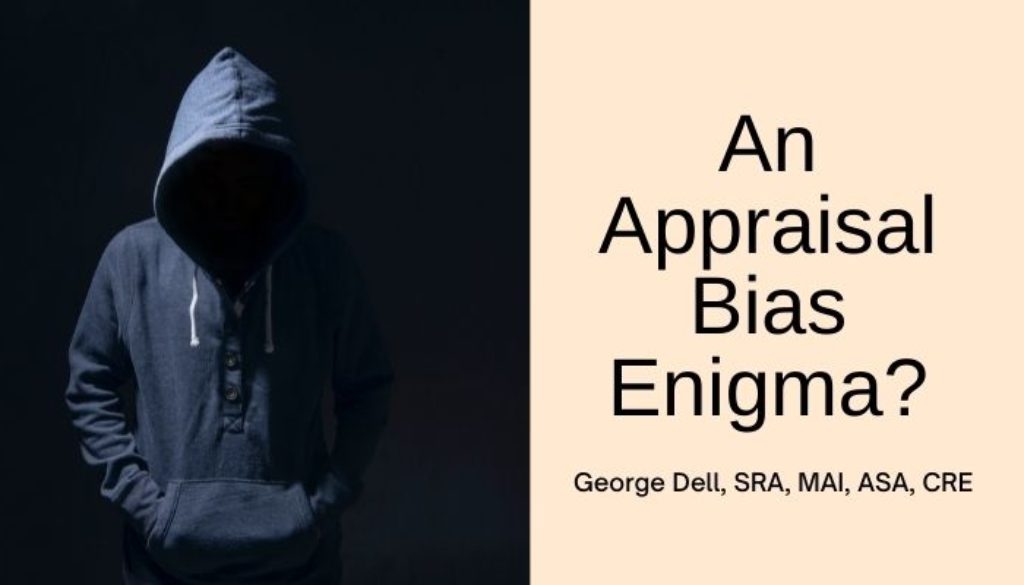Are valuation procedures a set up for bias failure? Let’s look to see what systemic issues there may be regarding bias in valuation. This is an enigma of multiple overlapping issues.
Let’s connect the “established” appraisal practice of USPAP (Uniform Standards of Professional Appraisal Practice), the established body of knowledge (EBOK), and human behavior reality.
Warning: reality may be offensive to some readers. It may conflict with personal beliefs and values. It can cause side effects, and should be avoided by those with established cognitive unease.
There are actually three aspects of the bias puzzle :
- The cognitive conflict between USPAP and EBOK
- The historical bias-allowing analytic practices
- Lack of training in implicit unconscious bias
First, we need to recognize the USPAP/EBOK conflict. Appraisal practice — as recently reiterated by the Appraisal Institute BOK (Body of Knowledge) committee – requires the appraiser to carefully select comparables similar, competitive, and “able to be compared.” Predominant practice prefers the use of the “best” three to six comparables. (How to determine what is “best” is nowhere to be found in appraiser education.)
USPAP, contrarily, requires that “An appraiser must analyze such comparable sales data as are available.” This may be two comparable sales, twenty comparable sales, or two-hundred. Nowhere in USPAP does it say the best three to six comparables. Nowhere.
It appears that the traditional practice of discarding information [i] beyond an arbitrary handful is a matter of tradition, regurgitated education, and groupthink. It is further reinforced by appraisal reviewers, client expectations, and enforcement by ±60 regulatory agencies. Appraisers attempting to improve the precision and accuracy (trueness and sureness) of their analysis are subject to resistance and even disciplinary action for better, but “unaccepted” practice
Second, these current “established” practices allow and enable bias!
A basic, fundamental principle of the science of data analysis – is that all relevant data be used. Not a cherry-picked handful that feel nice.
While a conscientious appraiser will carefully cherry-pick carefully for subjective similarities, an unconscientious appraiser may just as easily pick comps to best support the pre-indicated needed number. An unconscious appraiser will also pick comps to support the pre-indicated needed number, even if he/she has a strong desire to be impartial and objective.
Consciousness can only come from awareness of the human condition of brain behaviors. Bias features can help us identify a member of the bad enemy tribe (a good thing). But bias can be quite damaging in modern society functions.
So here is an internal USPAP conflict: SR-1 says use all relevant data, while the “Scope of Work Rule” says do what peers do and what clients expect. What is done and expected is an appraisal process which allows, enables, and conceals intended and unintended bias!
Conclusion: To be successful, future valuation training must include: 1) an understanding of the nature of human unconscious bias. 2) Valuation development must comprise all relevant sale data, not just a hand-picked, subjectively selected data set.
This education, and “complete data” concept must be required of all valuers: Appraisals, AVMs, evaluations, inspectors, reviewers, and even – even regulators.
Any disparity from the above ‘rule’ will cause market discrimination, and unintended consequences.
[i] Read George Dell’s most recent journal articles published in The Appraisal Journal on this and other topics. Regression, Critical Thinking, and the Valuation Problem Today, Summer, 2017 ed. And Common Statistical Errors and Mistakes: Valuation and Reliability, Fall, 2013 ed.

September 15, 2021 @ 10:48 am
George, thank you once again for hitting the head of the nail. And, introducing new words or our vocabulary.
September 20, 2021 @ 8:51 am
There it is! So wisely and concisely said George!